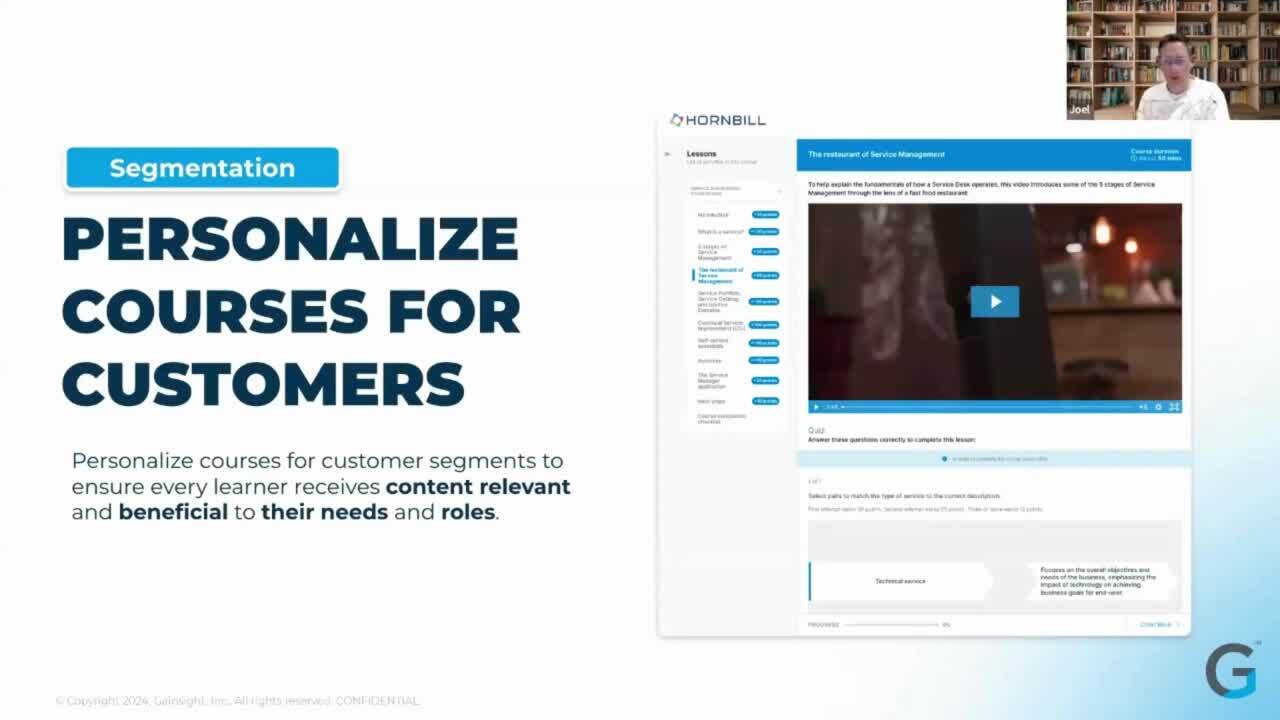Kevin Costner’s famous quote from Field of Dreams, “If you build it, he will come,” still inspires millions, but it doesn’t apply to your digital customer academy.
You can devote yourself to finding the perfect leader, setting realistic goals, and customizing every corner of your academy, but launching an impactful program requires more than a sturdy infrastructure; it requires courses that guide your customers to their desired outcomes.
Without that, you’ll be up a creek without a paddle.
But fear not. We have the paddle (in fact, we have three paddles) built upon the insights shared by industry experts Lila Meyer, Director of Global Education Services at Gainsight, and Joel Eaton, Head of Product eLearning at Hornbill, during our New Year, New Strategies Boot Camp Series. (Here’s a sneak peek of what Joel said.)

Before You Start Building, Create Personas
Generic, one-size-fits-all content isn’t the enemy, but it will prevent you from creating courses that truly benefit your customers. In other words, to create courses that meet the unique needs of your customers, you need to start by building detailed personas that give you insight into their goals, motivations, learning styles, and more.
Go through this exercise—solo or with your team—for the customer segments you’re creating courses for right now.
Ask yourself:
- What are their business and product goals?
- Where are they in the customer journey?
- What motivates them?
- What keeps them up at night?
- How do they want to learn?
- How do they measure success with your product?
Once you have your persona(s), you can start building courses that speak directly to the customers relying on your academy to help them unlock your product’s total value.
For Joel, his persona evaluation allowed him to create courses based on where Hornbill’s customers are in their journey. For example, he created a course on service management fundamentals geared toward new Hornbill customers, while a course on a more advanced topic is reserved for customers who’ve been around for years.

Meanwhile, Lila segments Gainsight customers by role (admins vs. end-users). CS admins, for example, typically receive more hands-on learning to help them make the most of Gainsight CS. At the same time, CS end-users get shorter, task-oriented courses.
Use AI Wisely
The rise of AI tools is rightfully catching the attention of Customer Education teams, but they’re also leading them down a dangerous path—and for one simple reason: AI doesn’t know your customers, and it never will. You and your team are the only ones who understand your customers well enough to create courses that move the needle for them.
That said, I can’t dismiss AI completely; it still has a place in your content creation process.
For example, you can ask ChatGPT—or other tools—to create:
- A course outline
- A video script
- Questions for a quiz
- Creative course names or a description
- An email or social post to promote your courses to customers
AI is your friend, not your replacement. Use it to speed up course creation and give your team back time to spend on higher-value activities that drive your customers to successful outcomes that reduce churn and increase lifetime value (LTV) and health scores.
Measure Impact and Iterate
Lila said, “I attribute a lot of Gainsight University’s success to our commitment to consistently measuring the impact of our courses, pinpointing what’s working—and what’s not—and then evolving based on what we’re seeing to make our courses more impactful for Gainsight customers.”
While the topic of measurement often invites lively debate, measurement purely about course effectiveness is relatively straightforward because you can measure it with metrics available in many learning management systems (LMS).
I’m talking about:
- Course completion rates
- Quiz scores
- Survey responses
While completion rates and quiz scores won’t give you a complete view of the overall impact of your customer education program, these content-level metrics will give you a pretty darn good idea of whether or not your courses are doing the trick. Dive into them, pinpoint areas for improvement—maybe courses with high drop-off rates—and switch things up.
For example, Lila uses in-app surveys (via Gainsight PX) at the end of each course to collect a satisfaction rating (out of 5 stars) and give customers a chance to leave a comment. Then, Lila and her team review that feedback and iterate courses accordingly.
On one occasion, Lila heard that Customer Success Managers (CSMs) needed more best practices on using Gainsight CS, so she worked with her team to update Gainsight University’s (GSU) foundational courses to showcase a Gainsight CSM’s typical workflow. The subsequent feedback was positive and now that course consistently sees the most completions.
The Journey Doesn’t End with Course Creation
Appointing a leader, setting smart goals, customizing your academy, and creating impactful courses are key building blocks on your path to customer education success, but your journey isn’t over when you check these boxes.
Your short- and long-term success relies on your commitment to embracing a constant cycle of learning, iterating, and improving in the best interest of your team and customers. Our boot camp series kicking off the year will help you do just that.
Learn More
Check out Lila and Joel’s on-demand webinar to hear more about course creation best practices. For additional insights, explore our full New Year, New Strategies series, or register for our remaining sessions.
